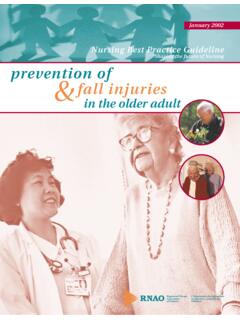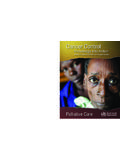Transcription of Hospice-Veteran Partnership Toolkit - Network of Care
1 2nd Edition Hospice-Veteran Partnership Toolkit Ensuring Excellent care for Our Nation's veterans . PLEASE NOTE: All Reader CD pages have search capabilities. Just click on the Chapter name, Web or e-mail address or references to other sections and you will automatically be transferred. Click on the top of any page and you will be transferred back to the Table of Contents. Hospice-Veteran Partnership Toolkit Ensuring Excellent care for Our Nation's veterans . Table of Contents Introduction 3. I. Considering Potential Partners 7. II. Forming a Hospice-Veteran Partnership 11. III. Building a Strong Foundation 13. IV. Conducting a Needs Assessment 22. V. Understanding hospice and Palliative care and the Medicare hospice Benefit 23. VI. Exploring veterans ' Issues and the VA Health care System 26.
2 VII. Acknowledgements 38. VIII. APPENDIX 39. 2a: Sample Invitation to HVP Information Meeting ..40. 2b: NHPCO Letter ..41. 2c: VA Memo ..42. 2d: Sample Agenda for HVP Information Meeting ..43. 2e: Sample Handout for HVP Information Meeting ..44. 2f: Sample Form to Assess Areas of Interest ..45. 3a: Confirmation of Agreement: Leadership Committee ..46. 3b: Sample Invitation to First HVP Meeting ..47. 3c: Sample Agenda for First HVP Meeting ..48. 3d: Sample HVP Fact 3e: Sample HVP Vision, Mission and Objectives ..50. 4a: Sample Survey Letter for Hospices ..51. 4b: Sample Survey Tool for Hospices ..52. 4c: Sample Survey Letter for VA Facilities ..56. 4d: Sample Survey Tool for VA Facilities ..57. 5a: Military Service History Pocket Card Fact Sheet ..62. 5b: HVP Process and Outcome Measures.
3 64. 1. Hospice-Veteran Partnership Toolkit Ensuring Excellent care for Our Nation's veterans . VA 101 Toolkit (IN VA DOCUMENTS FOLDER ON CD). NOTE: For ease in locating the desired document, file names appear in bold italics after the document name below. For example: VA 101: State veterans Homes: StateVetHomes. To open this file, find StateVetHomes and double-click. POWERPOINT SLIDE SETS. VA 101: Basic Training for Understanding the Department of veterans Affairs: BasicTraining VA 101: hospice and Palliative care in VA: HospicePCVA. VA 101: State veterans Homes: StateVetHomes VA 101: Hospice-Veteran Partnerships: HVPartners ADDITIONAL RESOURCES. VA Alphabet Soup: AlphabetSoup Veteran Certificates: VetCerts VA Brochures and Booklets: VA Organizational Briefing Book May 2006: BriefingBook Summary of VA Benefits: BenefitSummary Veteran Population Model, VetPop 2004 Version May 2007: VetPopModel Military History Pocket Card (PDF file): PocketCard VA Transforms End-of-Life care for veterans : VATransforms Fact Sheets Burial Benefits Fact Sheet: BurialBenefits Department of veterans Affairs Fact Sheet: DVAF acts Enrollment Priority Groups Fact Sheet: EnrollPriority veterans Health Administration hospice and Palliative care Definitions Fact Sheet: Definitions veterans Health Administration hospice care Referral and Purchase Procedures Handbook Fact Sheet: RefProHand Hospice-Veteran Partnership Fact Sheet.
4 HVPF acts Military History Pocket Card Fact Sheet: PocketCardFacts FAQs VA Prescriptive Authority and Collaboration with Community hospice Programs (Community Version) FAQ: PresAuthColFAQ. VA hospice Policies FAQ: PoliciesFAQ. VHA Handbooks August 2004: Home Health and hospice care Reimbursement Handbook: ReimbHandbook March 2005: Community hospice care : Referral and Purchase Procedures: CompHospCare July 2006: Purchased Home Health care Services Procedures: PurchHHCare 2. Hospice-Veteran Partnership Toolkit Ensuring Excellent care for Our Nation's veterans . Introduction Building Partnerships to Better Serve veterans A P o p u la t io n in N e e d o f Q u a li t y E n d - o f - L i f e C a r e Mr. C is a n 86 -ye ar- old vet eran with end-stage heart failure and moderate dementia.
5 After surviving some of the toughest fighting in World War II, he went on to earn a law degree and establish a successful practice. Mr. C never talked about the war with his family. They never thought to mention it to his doctors or the nursing home staff. Mr. C is haunted by memories from more than half a lifetime ago. Observing his frequent tears and periods of profound depression his family and the nursing home staff realize something is wrong but they don't know how to comfort him. Mrs . J is a 67- yea r-old ve tera n who served as a nurse in Vietnam. She has been told by her doctor that she has less than six months to live. For the past two years, Mrs. J has been receiving treatment at a Department of veterans Affairs (VA) Medical Center an hour away. Although she still wants to maintain contact with VA staff, she is no longer able to make the trip to the VA Medical Center and has decided to spend her remaining time in the comfort of her home.
6 Mr. L is a 56-year-old veteran with end-stage liver disease and a limited prognosis. He lost a leg in Vietnam and has struggled with alcohol abuse and depression since returning to the United States. Now homeless and with no income or family support, he is in a VA hospital after collapsing outside an office building. These stories represent just a few of the more than 600,000 veterans who are expected to die each year well into the next decade. Many of these veterans could benefit from hospice care , an end-of-life care choice that provides dying patients and their loved ones with comfort, compassion and dignity. hospice care involves a patient-centered, team-oriented approach to expert medical care , pain management, and emotional and spiritual support. care can be provided in a number of settings, including patients' homes, inpatient hospice units, hospitals, nursing homes, and long-term care facilities.
7 At the center of hospice care is the belief that everyone has the right to die pain-free and with dignity. The emotional and spiritual components of hospice care can be especially meaningful to veterans who often face issues near the end of life relating to their military experiences. Support is even more crucial for veterans who do not have a strong support Network of family and friends. 3. Introduction Hospice-Veteran Partnership Toolkit Ensuring Excellent care for Our Nation's veterans . A Fragmented System Anyone who has tried to navigate the health care system in America knows that often there is fragmented communication and coordination of services among health care providers, public and private insurance companies, and patients and families. Even though the Department of veterans Affairs (VA) is the largest integrated health care system in the country there are still issues.
8 So how can we ensure veterans receive quality end-of-life care ? It's an important question to answer--particularly when considering these facts from the VA: More than 1,800 veterans die every day. This represents a quarter of all deaths in America. Approximately 85% of veterans do not receive care through the VA health care system. Most veterans still die in the community; only 4% of veteran deaths occur in VA facilities. These statistics highlight the importance of partnerships among VA and community health providers as well as organizations that serve veterans . There is a great need for education about hospice care and how it can be accessed. hospice care is part of the basic eligibility package for veterans enrolled in the veterans Health Administration (VHA). (See Title 38 Code of Federal Regulations (CFR) (a)(1)(xi)(A).)
9 If hospice care is appropriate for enrolled veterans and has been approved by a VA physician, VA medical centers will either provide hospice care directly in their facilities or purchase it from community hospices. All Medicare-eligible veterans , whether or not they are enrolled in VHA, have access to hospice care through Medicare. veterans not eligible for Medicare may have hospice benefits through Medicaid or other private insurance. However, like 90% of all Americans, most veterans simply don't know that these options exist. The need for education extends beyond the public to community hospice and VA providers as well. Many community hospices are unaware of the dedicated inpatient hospice units that exist in VA facilities. Likewise, VA facilities are often unfamiliar with the services community hospices can offer and how to work with them.
10 There are also complex issues surrounding payment reimbursement and administration. 4. Introduction Hospice-Veteran Partnership Toolkit Ensuring Excellent care for Our Nation's veterans . Hospice-Veteran Partnerships (HVPs). With a focus on improving end-of-life care for veterans , the Department of veterans Affairs established their hospice and Palliative care Initiative (VAHPC) in November of 2001. One of the programs launched by VAHPC. is the National Hospice-Veteran Partnership (HVP) Program, which is working with the National hospice and Palliative care Organization, the Center for Advanced Illness Coordinated care , and other end-of-life care advocates to create a national Network of HVPs. HVPs are coalitions of Department of veterans Affairs (VA) facilities, community hospices, end-of-life care or community organizations and others working together to ensure that excellent care at the end of life is available for our nation's veterans and that support is available for their families.








